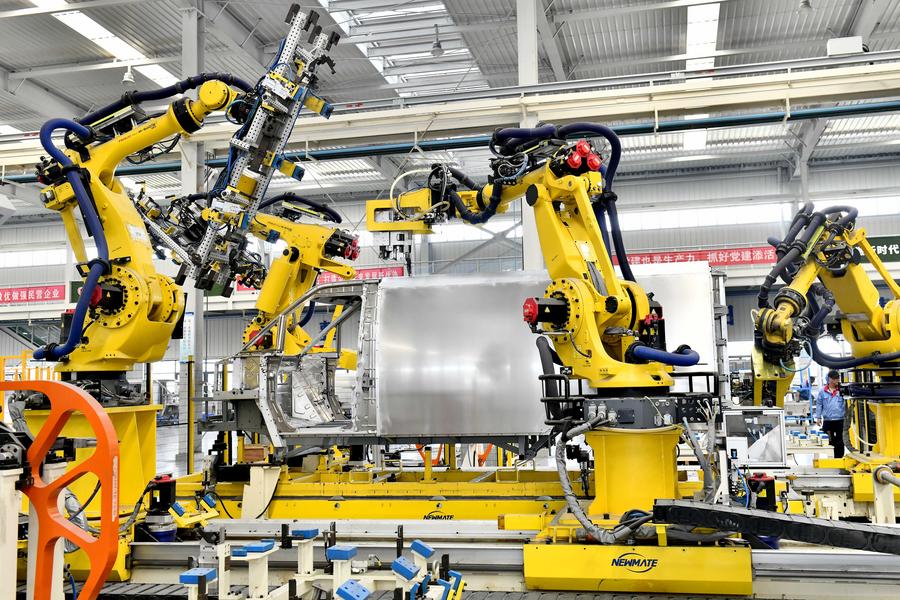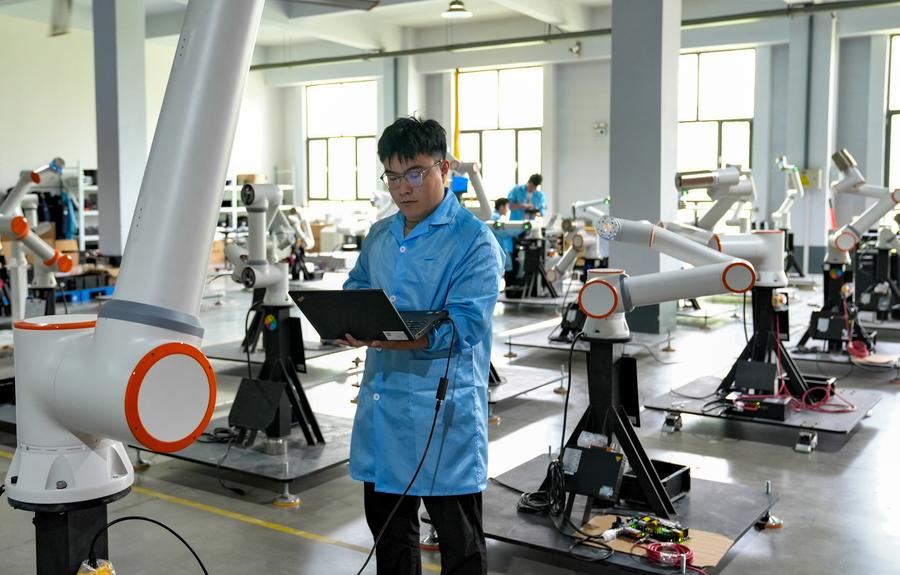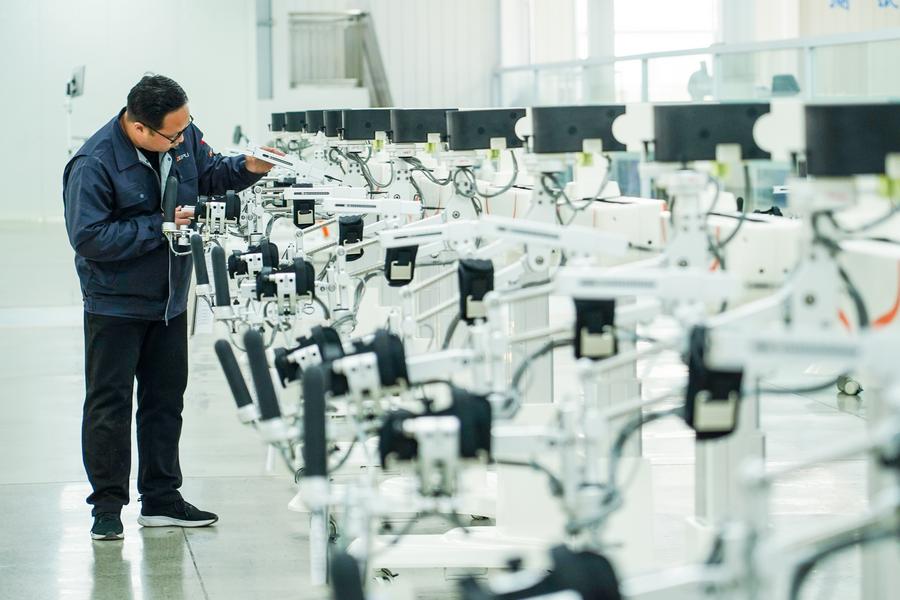Made-in-China robots empower upgrading of manufacturing industry
JINAN, July 1 (Xinhua) -- At the green energy-powered engine manufacturing base of Weichai Power Co., Ltd. in east China's Shandong Province, automated guided vehicles shuttle and position engine parts via QR codes, to ensure they reach their different production line locations.
Weichai, a leading Chinese powertrain manufacturer based in Weifang, has extensively implemented the use of industrial robots in its smart factories. Almost no manual operation can be seen on the entire production line.
Thanks to the rapid growth of industrial robot production capacity, China's installed capacity of industrial robots currently accounts for more than 50 percent of the world's total. More and more manufacturing companies have improved their production efficiency by using industrial robots. Made-in-China robots are contributing to the upgrading of the manufacturing industry, both at home and abroad.

Robots work on an assembly line of aluminium vehicle body in Zouping, east China's Shandong Province, Sept. 13, 2023. (Xinhua/Guo Xulei)
IMPROVED PRODUCTION EFFICIENCY
Weichai's equipment automation rate is as high as 99 percent. Through various technologies, including industrial robots, the factory's production process is mostly free from dependence on manpower and experience, and the production line can quickly realize smart adjustments, according to the company.
With the expanded use of robots, Weichai has greatly improved production efficiency. Its production line for green energy-powered engines only needs one-fifth of the workforce required before the implementation of these changes.

A technician makes rehabilitation robots at Gaomi Park of Weifang High-Tech Industry Development Zone in Gaomi, east China's Shandong Province, April 17, 2024. (Xinhua/Zhu Zheng)
China was the world's largest industrial robot market in 2022, with a density of 392 units per 10,000 workers in the manufacturing industry. Data from the Ministry of Industry and Information Technology showed that in 2022, China's output of industrial robots had exceeded 443,000 units, up over 20 percent year on year.
Statistics also showed that there are currently more than 1.5 million robots in operation in factories in China, twice the figure recorded in Europe. In 2023, China alone had installed more than half of the world's new industrial robots, according to the International Federation of Robotics.
Manufacturing practitioners believe that the application of robots not only improves production efficiency but also speeds up product iteration. A decade ago, it would have taken Weichai five years to develop a new product, but now, with the smart system, the development cycle can be shortened to 18 months.
VARIOUS APPLICATION SCENARIOS
The FAIR Innovation (Zibo) Robot Technology Co., Ltd. in the city of Zibo, Shandong, was established in 2019, and currently produces six types of robots with a loading capacity ranging from 3 kg to 30 kg, which are widely used in welding, spraying, precision processing, and catering.
"We attach great importance to research and development investment. The core components of robots, such as controllers, reducers, and motors, are all independently developed and produced by our company," said Wang Min, the company's executive general manager.
China's industrial robot manufacturing technologies are rich in diversity and flexibility. There is now a greater variety of industrial robots, while the application scope is expanding.

A technician adjusts robots at a workshop in Zibo City, east China's Shandong Province, May 12, 2024. (Photo by Yang Mingchao/Xinhua)
For example, Uroica Precision Information Engineering Co., Ltd. is developing robots for mine inspection, while Shenzhen Sunwin Intelligent Co., Ltd. produces a variety of industrial inspection robots and independently develops an inspection operation and maintenance platform that can be applied in different industrial application scenarios and which can eliminate the need for manual inspection tasks. In addition, the accelerated development of e-commerce means that logistics robots also have more applications and potentials.
"We hope to upgrade robots from specialists to generalists. Currently, robots complete specific tasks in a specific scenario. Although robots have done a good job concerning certain tasks, some still have issues due to uncertainties in the real world," said Yi Li, assistant professor at the Institute for Interdisciplinary Information Sciences, Tsinghua University. "Robots that are generalists will be able to perform open tasks in an open environment."
Once a robot becomes a generalist, it will have a huge application space. Zhang Jianwei, a foreign academician of the Chinese Academy of Engineering, said that in scenarios such as rescue, autonomous driving, modern agriculture, and home services, smarter robots will have more room to play.
EXPLORING OVERSEAS MARKETS
Chinese robotics companies have achieved good results in exploring overseas markets in recent years. Some companies are exploring markets in countries and regions that have an aging population problem and high labor costs, such as the United States, Europe, Japan, and the Republic of Korea.
Latin America, Southeast Asia, and other regions where development of the manufacturing industry is rapid, but where the overall quality of the labor force is often unable to meet the needs of industrial upgrading, have also become target areas for Chinese robotics companies.
Dobot Robotics, headquartered in south China's Shenzhen, has branches in the United States, Germany, and Japan as well as more than 350 core agents worldwide. Its products have been sold to over 140 countries and regions.

A technician makes rehabilitation robots at Gaomi Park of Weifang High-Tech Industry Development Zone in Gaomi, east China's Shandong Province, April 17, 2024. (Xinhua/Zhu Zheng)
At Dobot Robotics's manufacturing base in the city of Rizhao, Shandong, robots are made via a fully-automated production line. The line was put into operation in 2022, and the 10,000th robot rolled off the line in September of the same year.
"Our main products are collaborative robots and supporting solutions. Relying on the production capacity of the factory in Rizhao, the company has carried out global marketing and promotion of products and has become the largest exporter of domestic robots for five consecutive years," said Liu Chanchan, general manager of the company's Rizhao base.
Over half of the company's sales stem from demand overseas. Overseas markets have a higher awareness of industrial robots, while offering a large market space and high maturity. In addition, human resources in some countries are more scarce, and so their demand for robots is more urgent, Liu added.
Photos
Related Stories
- China's manufacturing PMI remains flat in June
- China's electronic information manufacturing industry reports January-May expansion
- China's electronics manufacturing sector expands on strong production, exports
- China speeds up digital transformation of manufacturing sector
- Letter from China: Two types of weaving machine tell story of China's industrial upgrading
Copyright © 2024 People's Daily Online. All Rights Reserved.









